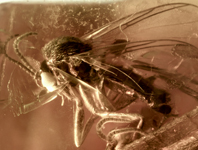Abstract
A new monotypic genus of Prodidominae, Indiani gen. nov., is proposed to include one cave species collected in limestone caves from Minas Gerais, Brazil: Indiani gaspar sp. nov. (♂♀). Based on a recent phylogenetic analysis of Prodidominae, the new genus is closely to other Neotropical Prodidominae, such as Lygromma, Brasilomma and Moreno by sharing a classic claw tuft clasper. Indiani gen. nov. is characterized by a ventral parallel rows of strong spines on tibia and metatarsus I–II, male palp with sclerotized conductor and the robust median apophysis is curved retrolaterally; the female epigyne has an anterior atrium and a posterior extension of the epigynal plate. As other cave Prodidominae, Indiani gen. nov. has morphological characteristics, such as loss or reduction of eyes and weak pigmentation, that indicate an adaptation for living in subterranean environments.
References
Azevedo, G.H.F., Griswold, C.E. & Santos, A.J. (2018) Systematics and evolution of ground spiders revisited (Araneae, Dionycha, Gnaphosidae). Cladistics, 34, 579–626.
https://doi.org/10.1111/cla.12226
Brescovit, A.D., Ferreira, R.L., Souza-Silva, M. & Rheims, C.A. (2012) Brasilomma gen. nov., a new prodidomid genus from Brazil (Araneae, Prodidomidae). Zootaxa, 3572 (1), 23–32.
https://doi.org/10.11646/zootaxa.3572.1.4
Christiansen, K. (2012) Morphological adaptations. In: White, W.B. & Culver, D.C. (Eds.), Encyclopedia of Caves. Academic Press, Waltham, pp. 517–528.
https://doi.org/10.1016/B978-0-12-383832-2.00075-X
Ferreira Júnior, O. (2001) GPS Trackmaker Guia de Referência. Belo Horizonte. Available from: http://www.gpstm.com/ download/ref_guide_port.pdf (accessed 1 June 2019)
Holsinger, J.R. (1988) Troglobites: the evolution of cave-dwelling organisms. American Scientist, 76, 146–153.
Peck, S.B. & Shear, W.A. (1987) A new blind cavernicolous Lygromma (Araneae, Gnaphosidae) from the Galápagos Islands. The Canadian Entomologist, 119 (2), 105–108.
https://doi.org/10.4039/Ent119105-2
Platnick, N.I. & Shadab, M.U. (1976) A revision of the spider genera Lygromma and Neozimiris (Araneae, Gnaphosidae). American Museum Novitates, 2598, 1–23.
Ramirez, M.J. (2014) The Morphology and Phylogeny of Dionychan Spiders (Araneae; Araneomorphae). Bulletin of the American Museum of Natural History, 390, 1–374.
Rheims, C.A. & Brescovit, A.D. (2004) A new cave spider of the genus Lygromma Simon (Araneae, Prodidomidae) from Minas Gerais, Brazil. Revista ibérica de aracnología, 9, 325–327.
Rodrigues, B.V.B. (2018) Análise filogenética da subfamília Prodidominae Simon 1884 e taxonomia dos gêneros aficanos (Arachnida; Araneae; Gnaphosidae). Tese de Doutorado em Zoologia, Instituto de Biociências, Universidade de São Paulo, São Paulo, 312 pp.
Rodrigues, B.V.B, Cizauskas, I. & Rheims, C.A. (2018) Description of Paracymbiomma gen. nov., a new genus of prodidomid spiders from the Neotropical region (Araneae: Prodidomidae) including a new troglobite species. Zootaxa, 4514 (3), 301–331.
https://doi.org/10.11646/zootaxa.4514.3.1
World Spider Catalog (2019) World Spider Catalog. version 17.0. Natural History Museum Bern. Available from: http://wsc.nmbe.ch (accessed 1 June 2019)

